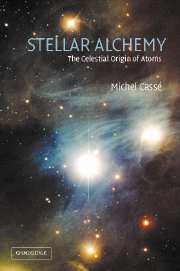Book contents
- Frontmatter
- Contents
- Preface
- Acknowledgements
- 1 Nuclear astrophysics: defence and illustration
- 2 Light from atoms, light from the sky
- 3 Visions
- 4 Contents of the sky: atomic sources and fountains
- 5 Nuclear suns
- 6 Sociology of stars and clouds
- 7 Histories
- 8 Ancient stars in the galactic halo
- 9 Conclusion
- Appendix 1 Invisible matter and energy
- Appendix 2 Supernovas and cosmology
- Appendix 3 Explosions
- Appendix 4 Stellar nucleosynthesis
- Appendix 5 Galactic evolution
- Appendix 6 Key dates
- Appendix 7 Constants and units
- Appendix 8 Websites
- Bibliography
- Index
Appendix 2 - Supernovas and cosmology
- Frontmatter
- Contents
- Preface
- Acknowledgements
- 1 Nuclear astrophysics: defence and illustration
- 2 Light from atoms, light from the sky
- 3 Visions
- 4 Contents of the sky: atomic sources and fountains
- 5 Nuclear suns
- 6 Sociology of stars and clouds
- 7 Histories
- 8 Ancient stars in the galactic halo
- 9 Conclusion
- Appendix 1 Invisible matter and energy
- Appendix 2 Supernovas and cosmology
- Appendix 3 Explosions
- Appendix 4 Stellar nucleosynthesis
- Appendix 5 Galactic evolution
- Appendix 6 Key dates
- Appendix 7 Constants and units
- Appendix 8 Websites
- Bibliography
- Index
Summary
Properties of supernovas
At first glance, the spectral properties, absolute magnitudes (intrinsic luminosities) and shapes of the light curves of the majority of type Ia supernovas (SNIa) are remarkably similar. Only a few rather subtle photometric and spectrometric differences can be discerned from one object to another.
Hydrogen shines by its absence and the optical spectra of SNIa events feature spectral lines of neutral and once ionised elements (Ca+, Mg+, S+ and O+) at the minimum of the light curve. This indicates that the outer layers are composed of intermediate mass elements. SNIa events reach their maximum luminosity after about 20 days. This luminous peak is followed by a sharp drop amounting to three magnitudes per month. Later the light curve falls exponentially at the rate of one magnitude per month.
The exploding stars discussed here of a much more modest character than gravitational collapse supernovas, which arise when the core of a gigantic star gives way. However, they eject matter at very high speeds, up to 10 000 km s−1, and release a comparable amount of energy, some 1051 erg. They are genuine nuclear bombs, unlike the gravitational-collapse supernovas (SNII), which draw their energy from gravity.
- Type
- Chapter
- Information
- Stellar AlchemyThe Celestial Origin of Atoms, pp. 211 - 215Publisher: Cambridge University PressPrint publication year: 2003



